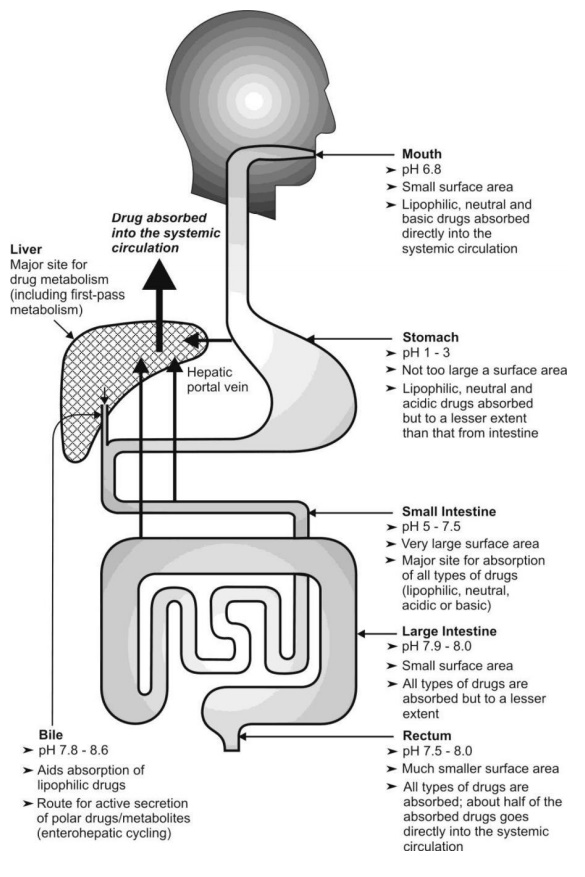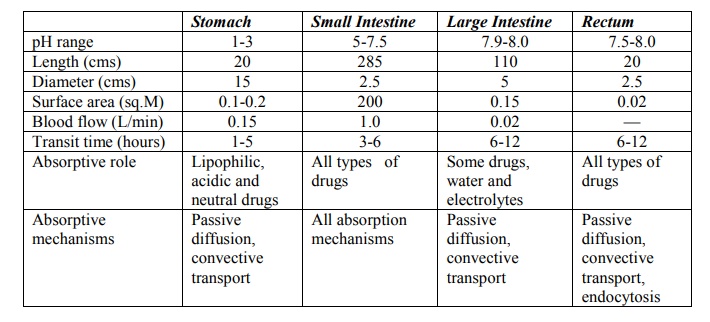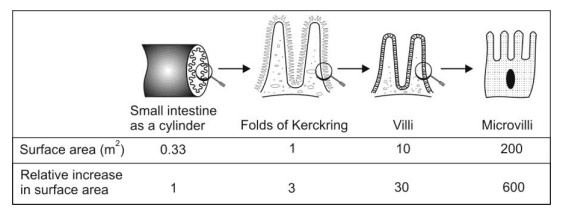Gastrointestinal tract
| Home | | Biopharmaceutics and Pharmacokinetics |Chapter: Biopharmaceutics and Pharmacokinetics : Absorption of Drugs
The gastrointestinal tract (GIT) comprises of a number of components, their primary function being secretion, digestion and absorption.
PATIENT RELATED FACTORS AFFECTING DRUG ABSORPTION
Before dealing with the patient related factors influencing bioavailability of a drug, the anatomy and physiology of the gastrointestinal tract will be discussed briefly.
Gastrointestinal tract
The gastrointestinal tract (GIT) comprises of a number of components, their primary function being secretion, digestion and absorption. The mean length of the entire GIT is 450 cm. The major functional components of the GIT are stomach, small intestine (duodenum, jejunum and ileum) and large intestine (colon) which grossly differ from each other in terms of anatomy, function, secretions and pH (Fig. 2.28 and Table 2.7).

Fig. 2.28. Schematic representation of the GIT and different sites of drug absorption
TABLE 2.7.
Anatomical and Functional Differences Between the Important Regions of the GIT

The entire length of the GI mucosa from stomach to large intestine is lined by a thin layer of mucopolysaccharides (mucus/mucin) which normally acts as an impermeable barrier to the particulates such as bacteria, cells or food particles.
Stomach: The stomach is a bag like structure having a smooth mucosa and thus small surface area. Its acidic pH, due to secretion of HCl, favours absorption of acidic drugs if they are soluble in the gastric fluids since they are unionised to a large extent in such a pH. The gastric pH aids dissolution of basic drugs due to salt formation and subsequent ionisation which are therefore absorbed to a lesser extent from stomach because of the same reason.
The stomach is not the principal region for drug absorption because –
1. The total mucosal area is small.
2. The epithelium is dominated by mucus-secreting cells rather than absorptive cells.
3. The gastric residence time is limited due to which there is limited opportunity for gastric uptake of drug.
Small Intestine: It is the major site for absorption of most drugs due to its special characteristics –
1. Large surface area – the folds in the intestinal mucosa, called as the folds of Kerckring, result in 3 fold increase in the surface area. The surface of these folds possess finger like projections called as villi which increase the surface area 30 times. From the surface of villi protrude several microvilli (about 600 from each absorptive cell that lines the villi) resulting in 600 times increase in the surface area (Fig. 2.29).
2. Great length of small intestine (approximately 285 cms) – result in more than 200 square meters of surface which is several times that of stomach.
3. Greater blood flow - the blood flow to the small intestine is 6 to 10 times that of stomach.
4. Favourable pH range – the pH range of small intestine is 5 to 7.5 which is favourable for most drugs to remain unionised.
5. Slow peristaltic movement – prolongs the residence time of drug in the intestine
6. High permeability – the intestinal epithelium is dominated by absorptive cells.
A contribution of all the above factors thus make intestine the best site for absorption of most drugs.

Fig. 2.29. Representation of the components of intestinal epithelium that accounts for its large surface area
Large Intestine: Its length and mucosal surface area is very small (villi and microvilli are absent) in comparison to small intestine and thus absorption of drugs from this region is insignificant. Its contents are neutral or alkaline. The main role of large intestine is in the absorption of water and electrolytes. However, because of the long residence time (6 to 12 hours), colonic transit may be important in the absorption of some poorly soluble drugs and sustained release dosage forms.
Related Topics
